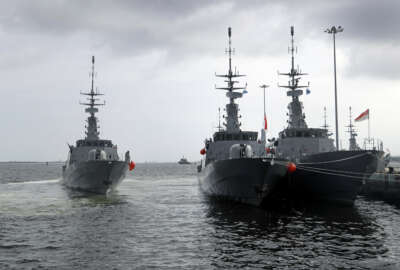

Although failures of basic seamanship and training were largely to blame for last year's collisions, the Navy says it also needs to fix basic problems with the...
Subscribe to Federal Drive’s daily audio interviews on iTunes or PodcastOne.
The Navy’s comprehensive review into last year’s fatal collisions involving the U.S.S. John McCain and U.S.S. Fitzgerald identified shortfalls in training, planning and basic seamanship standards as contributors to the deaths of 17 sailors, and the service is already taking corrective actions to reinforce the basics of navigation and teamwork.
But the 60-day study, led by U.S. Fleet Forces Command, also pointed to technical and equipping problems that the Navy doesn’t have immediate answers for: The hodgepodge of equipment that’s been incrementally added its warships’ bridges over time — particularly in the case of older vessels — makes the task of safely navigating those ships much more difficult than it needs to be.
“We’ve created a bit of a Frankenstein,” Adm. Philip Davidson, the commander of Fleet Forces Command told a conference hosted by the Surface Navy Association in Arlington, Va. on Thursday. “There has not been good control of the bridge as a control room in and of itself, on the destroyers specifically, but on our cruisers as well.”
The problem, Davidson said, is that vessels that were originally designed and built in the 20th century have had their bridges supplemented with a series of new 21st century navigation technologies that are also used by merchant vessels, but with no particular authority in charge of making sure those systems are easy to use, that one ship’s bridge configuration resembles another, or that the shore-side simulators used to train sailors match up with the systems that they’ll actually use when standing watch underway.
For instance, the review took note of standards for merchant vessels, which dictate that a ship’s radar plotting aid ought to be within view and arm’s reach of the officer of the deck. In the case of the Navy’s destroyers, it tends to be located at a workstation many steps away, and facing the wrong direction, Davidson said.
He noted those sorts of awkward and user-unfriendly configurations stand in stark contrast to the operations rooms on each ship, known as combat information centers (CICs), mainly because a single organization, the Program Executive Office for Integrated Warfare Systems, is in charge of designing and equipping them.
“The CIC is a jewel. It was a jewel in the 20th century, and if you’ve seen the modernization that’s gone into the destroyers and cruisers since then, it still is,” Davidson said, adding that the Navy also seems to have gotten its bridge configurations right with the new classes of warships it added in the current century, the Littoral Combat Ship and the destroyer U.S.S. Zumwalt.
“It’s a 21st century bridge on a 21st century ship, and it is a marvel,” he said. “And when you look at the trainer for the LCS up in Newport, you can watch ensigns without a lot of experience make that ship do its thing, and it is a marvel to watch. It is extraordinary: everything is right there at their fingertips.”
But that’s not necessarily the case for the majority of the service’s simulators, which Davidson said need to be greatly improved. The Navigation, Seamanship and Ship Handling Trainer (NSST) is now up and running at many of the service’s major installations, designed to give prospective bridge crew members a realistic experience of what it’s like to pilot a ship though various sea and traffic conditions before they begin qualifying on an operational vessel.
But much of the basic equipment in those NSSTs doesn’t adhere to the standards set by the Standards of Training, Certification and Watchkeeping for Seafarers (STCW), the international qualification baseline the Navy expects its personnel to meet.
“Nor does it reflect the equipment that’s actually aboard the ships,” Davidson said. “So it becomes an exercise in which the officer of the deck who’s getting trained might be able to manage his team and follow the rules of the road in a visual situation, but when the radars can’t be tuned and the team can’t be organized in the way you’d do it aboard the ship, it’s not everything it could be. So we’re looking for a much more robust simulator suite in the fleet concentration areas that actually reflects the bridge equipment.”
Among 14 other recommendations involving technical issues that may have contributed to the McCain and Fitzgerald incidents, the report recommended that the Navy designate a single organization with the responsibility and authority for the control systems on its vessels’ bridges, making sure they emphasize the importance of “human systems integration.”
Previously, some of those responsibilities have been dispersed not just throughout various Navy organizations, but left up to the commanding officers of individual ships.
“We have long given the COs the authority to put their own commercial radars on the ship, so now we’ve got dozens of variations of them throughout the fleet, and it’s both a training and a maintenance shortcoming,” Davidson said. “We’re going to replace that with a single radar or a family of radars with maintenance and training package associated with it. We also have some portable situational awareness piloting tools we’re trying to get to. There are some cyber challenges there, but we’ll get to that.”
Copyright © 2025 Federal News Network. All rights reserved. This website is not intended for users located within the European Economic Area.
Jared Serbu is deputy editor of Federal News Network and reports on the Defense Department’s contracting, legislative, workforce and IT issues.
Follow @jserbuWFED

